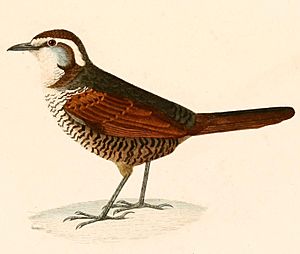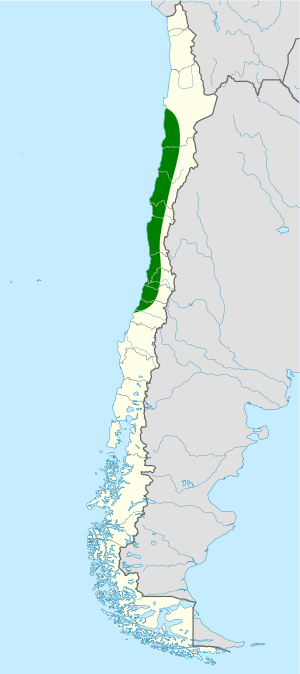White-throated tapaculo facts for kids
Quick facts for kids White-throated tapaculo |
|
|---|---|
 |
|
| Conservation status | |
| Scientific classification | |
| Genus: |
Scelorchilus
|
| Species: |
albicollis
|
 |
|
The white-throated tapaculo (Scelorchilus albicollis) is a small bird that lives only in Chile. It belongs to a bird family called Rhinocryptidae, known for their secretive habits. This bird gets its name from the white patch on its throat.
Contents
About the White-throated Tapaculo
The white-throated tapaculo has two main types, called subspecies. The first one, Scelorchilus albicollis albicollis, was first described in 1830. The second type, S. a. atacamae, was described later in 1924. These two types look a bit different from each other.
What it Looks Like
The adult white-throated tapaculo is about 19 cm (7.5 in) long. That's about the length of a regular pencil!
The main type of this bird has a reddish-brown forehead. It also has a bright white stripe above its eye, which is called a supercilium. Its upper body is gray-brown. The lower part of its back (rump) has light stripes. Its belly is whitish, becoming a pale reddish-brown further down. Most of its underside has dark brown stripes.
The other type, S. a. atacamae, looks similar but is lighter in color. Its upper body is much more gray than brown. Young tapaculos look like the adults but have stripes all over their bodies.
Where it Lives
The white-throated tapaculo is found only in Chile, a long, narrow country in South America.
The S. a. atacamae type lives in the northern parts of Chile, from the Antofagasta Region down to the northern Coquimbo Region. This area has dry, xeric shrublands with many bushes.
The S. a. albicollis type lives further south, from the Coquimbo Region down to the Maule Region. This part of Chile has more woodlands and scrub areas, similar to a Mediterranean climate with wet winters and dry summers.
These birds usually live from sea level up to 1,000 m (3,300 ft) high. Sometimes, they can be found even higher, up to 1,600 m (5,200 ft). Scientists believe these birds stay in the same area all year round and do not migrate.
How the White-throated Tapaculo Behaves
What it Eats
The white-throated tapaculo mainly eats arthropods. These are small creatures like insects and spiders. It usually looks for its food on the ground, hiding in thick bushes and plants.
Reproduction and Life Cycle
When it's time to build a nest, the white-throated tapaculo makes a cup-shaped nest from soft grass. This nest is built at the end of a long tunnel, which can be up to 2 m (6.6 ft) long!
The female bird lays her eggs in September and October. Both the male and female parents take turns sitting on the eggs to keep them warm (this is called incubating). They also both work together to feed their baby birds once they hatch.
What it Sounds Like
The white-throated tapaculo sings from the ground or from a low branch. Its typical song sounds like a series of "barking" notes that get lower in pitch. You can listen to an example here: [1].
Its call is a harsh, grunting sound. Some people have said it sounds a bit like a pig! You can hear an example of its call here: [2].
Conservation Status
The IUCN (International Union for Conservation of Nature) has looked at the white-throated tapaculo and decided it is a species of "Least Concern." This means that it is not currently in danger of disappearing.
The bird lives in a fairly large area, and some of these areas are protected. Even though scientists haven't counted every single bird, they believe there are many of them, and their numbers seem to be stable.
See also
 In Spanish: Tapaculo para niños
In Spanish: Tapaculo para niños


